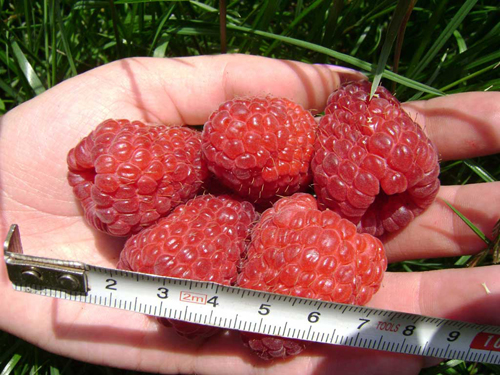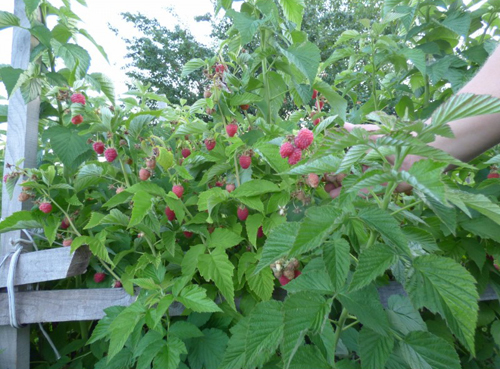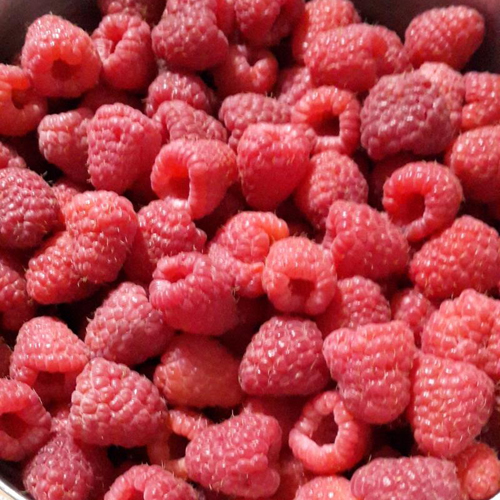Raspberry variety Tarusa
Not so long ago, the phrase “raspberry tree”, which appeared on the Russian market of planting material, excited the minds of all gardeners and summer residents without exception. Huge super-berries weighing from 20 grams, crazy yields of 15 kg or more from one raspberry bush, absolutely no trellis variety - the stems are like rigid iron rods. Of course, people's eyes lit up, and the hand immediately climbed to the wallet. After all, what is, for example, 1000 rubles for a real raspberry "palm"! Immediately there is a line of neighbors, waiting for the moment to get into your garden and even out of the corner of your eye to see this miracle. And if you're lucky, then beg, or rather, gratefully buy seedlings. One of these varieties is Tarusa. But is everything in her description fabulous, or is there a considerable grain of truth? More about this in our article below.

History of creation
This large-fruited summer raspberry was bred at the Moscow Institute of Horticulture and Nursery (VSTISP). In 1987, Russian breeders, headed by Professor V.V. Kichina, crossed two varieties - Stolichnaya and a shoots fortress donor Shtambovy-1. Among the experimental plantings in 1990, seedlings under the number K 50 were selected, corresponding to the required characteristics. Then, having made sure of the stability of the obtained varietal qualities in new generations, they began to multiply the raspberries, and she received the name Tarusa. Since 1993, it has been officially launched as a novelty. Russian patent number 1858.
Description
A variety of medium early ripening, ripening from the beginning of July (in the southern regions of the country). In other, more northern regions, from mid-July. The fruiting period is quite extended, some berries ripen even at the beginning of September.
The bush has a beautiful appearance, standard type, compact, has good growth vigor. Can produce 6-10 stems. Shoots grow to a height of 1.2-1.3 meters, up to a maximum of 1.5 meters. They are erect, tough, strong and resilient with short internodes, pubescent, with a slight waxy coating. Stems non-fledged, with a rosette of leaves at the top (escaping - a decrease in the thickness of the shoot, trunk from the base to the top). Raspberry root shoots give little, especially in the first years of life. Over time, when the root system of Tarusa develops well, the growth will become larger.
The shoots of this variety are completely thornless, strong, dense, up to 2 cm thick, green with a purple tint, with short internodes. In the second year, they become woody, become brownish in color. Lateral fruit branches are thickened, strong, rigid, have 2-3 orders of branching. Laterals are of medium length, close to each other. Each ripens 15-20 berries. One thing, but - with the ripening of numerous fruits, the loaded laterals can break off. Therefore, a garter to a support or trellis is desirable. The leaves of Tarusa are medium and large, straight, sometimes slightly twisted, oval, wrinkled, with jagged edges. They are deep green or dark green in color, the lower part is whitish, pubescent, as if velvety to the touch. The flowers are white, large, up to 1.5 cm in diameter. The flowering is amicable, begins in June.

Raspberry berries are wide, elongated, blunt-conical, light, bright red, sometimes even ruby in color, slightly pubescent, with a characteristic shine for the variety. They are heavy, large and very large, weighing 4-12 grams. The average weight of the fruit is 6-8 grams, and up to 15 grams can be poured as much as possible. The length of the berries is on average 2.5-3.5 cm, under suitable conditions it can reach up to 5 cm, the width is 2-2.5 cm.
The berry is homogeneous, leveled - and this, unfortunately, is not about Tarusa. During fruiting, deformed, twisted and doubled fruits are often encountered, significantly spoiling the general presentation of the crop. The way out - when selling, do not put such specimens on top or simply let them be processed, but leave even berries for sale, which are also enough.An unpleasant moment - the fruits of this variety can sometimes become covered with an ugly bluish bloom.
The berries of this raspberry are easily separated from the fruit, with a dry separation. They are quite dense, with a firm skin. When overripe, they do not crumble, continuing to hang on the bush for a relatively long time. Drupes are medium-sized, tightly interconnected. The bones themselves in them are small, practically imperceptible when consumed fresh and in processed products (jam, etc.). Tarusa fruits have an excellent aroma - it is persistent, thick, rich raspberry. But the taste of the berries is insipid, there is little sugar, expressionless, herbaceous and with a noticeable sourness. The pulp is firm, medium juiciness. Sometimes the fruits are just dryish. The transportability and keeping quality of the fruits are very good, they do not crumple even in small boxes, do not flow for a long time, retain their shape and presentation.
This is a variety that is mainly suitable for market trading and for all kinds of processing. Jams, jams, juices, compotes, jam are excellent from berries, suitable for drying and freezing. The fruits look very nice in jars of jam, if you do not digest it, alternating between cooking and cooling modes, while the berry remains intact. Thanks to the small bones, juices and syrups from this raspberry do not clog, as happens, for example, with blackberries. Also, Tarusa berries color the processed products well in a characteristic ruby color. Good alcoholic liqueurs are obtained from its fruits.

The yield of the variety is quite high, on average 3-4 kg per bush. Per hectare, with proper agricultural technology, productivity averages 15 tons, up to a maximum of 20 tons. The fruiting zone on the stem is generally between 0.5 and 1.2 meters. The stems stand upright only until the berries ripen. Ripening itself goes from top to bottom. And therefore, the ripening head of the bush is often the first to begin to tilt to the ground. And then the raspberry bush itself begins to bend over to the side. And the escape can then just break. Stems with ripening fruits are especially unstable to the wind. Even small impulses bend them, not to mention strong ones. Therefore, we repeat again - Tarusa needs a trellis or supports. Unless, of course, you want to pick berries from the ground. A good way to tie a variety: the first at a height of 40-50 cm and the second at a height of 1-1.2 meters, depending on the growth of the bushes. This will solve all the problems of plant resistance and will be a big plus in obtaining the entire volume of the expected yield.
The variety responds well to root zone mulching. Loves regular and abundant watering, watering with drip irrigation is especially good for the condition of plants. But our heroine does not like constant humidity, and this can have a bad effect on her health. The introduction of mineral fertilizers, and especially organic matter (rotted manure
There is a lot of confusion on the Internet, and in particular on summer cottages and horticultural forums, because of the second well, a very similar variety. This second hit "crimson tree" is also the brainchild of V.V. Kichina called Krepysh. And gardeners, growing Strong, think that they have Tarusa. And vice versa. Hence the confusion in raspberry descriptions and reviews. To be honest, we do not absolutely understand why to display two practically identical varieties. Although, in principle, of course we understand, but we will not voice it ... You probably already guessed it! The difference between them is mostly small: the fruits of Tarusa are a couple of grams more than those of Krepysh. The latter is less resistant to diseases and frost, has a weaker lobular root system and gives a lot of growth. It grows slightly lower, often up to 1.3 meters. The rest of the descriptions are more similar. Strong has the same thornless erect stems, inexpressive taste, good yield, large size of berries and good transportability. And he also leans when the crop ripens.

Tarusa is resistant to major raspberry diseases. Even in high humidity conditions, it is practically not affected by rot and didimella (purple spot). It is also resistant to some pests, in particular to stem gall midge. But aphids are often struck.Therefore, it is necessary to monitor its appearance and destroy it with insecticides, since in addition to mechanical harm, aphids also carry viral diseases. The frost resistance of the variety is average, up to -25-30 ° C. But it is advisable to cover the root system with mulch or agrofibre for the winter. Strong winds are especially dangerous together with winter frosts.
Now we will briefly describe all the strengths and weaknesses of our heroine.
Strengths
- High rates of productivity, keeping quality and transportability, fruits do not wrinkle and do not flow. Dry pull-off when collecting.
- The bush is compact, the sides branch well, but does not take up much space. Therefore, you can plant Tarusa denser and with a narrower row spacing. And get more berries from a smaller area.
- Mid-early ripening, yield at a time when there are few other raspberries on the market.
- Spectacular large and very large fruits with a thick raspberry aroma.
- Strong, elastic erect shoots, beautiful appearance of the bush.
- Complete absence of thorns in the variety.
- A small amount of root growth, which makes it easier to care for the plant, but creates problems for mass reproduction.
- Proven frost resistance down to -25-30 ° C. But all the same, it is better not to risk it and cover the plant for the winter, since there are known cases of freezing in winter during thaws, followed by a sharp drop in temperature.
- Tarusa berries are great for all kinds of processing (jam
etc. ).
- Due to its impressive size and good commercial characteristics of the fruit, the variety is in high demand on the market when it is sold.
- Good resistance to major common raspberry diseases and some pests.
Weak sides
- Prolonged fruiting period, there is no mass ripening in a short time. But this allows you to be with the berry throughout almost the entire summer.
- The taste is mediocre, bland, unsaturated, berries contain little sugar, sometimes dry.
- Often, gnarled, deformed and double fruits are formed.
- Raspberry shoots begin to bend under the weight of the fruit, the head of the bush bends to the ground first. Strong winds can break them. Laterals can also break off under the weight of the pouring berries. Tarusa's tapestry is sometimes not just needed, but extremely necessary.
- The high price of planting material due to the inflated popularity of the variety and the attributed qualities.
In the end, I would like to say a little about the price of planting material and the term "crimson tree" itself.
In the nineties of the last century, the Russian professor V.V. Kichina created standard varieties of raspberries with strong, tough, erect stems. And this played into the hands of the seedlings traders. Using the low awareness of buyers at that time, dishonest sellers named them trees. And for even greater excitement, they were credited with fantastic yield indicators, huge fruit sizes and other similar characteristics.
In 2006, V.V. Kichina proudly remarked: "Tarusa is sometimes called the 'raspberry tree' for its powerfully developed shoots and the bush as a whole." This is from the category of a grandiose scam that has successfully swept across Russia and Ukraine, called "curly strawberries". And as it turned out in practice after the purchase - ordinary remontant varieties with long mustaches and rosettes blooming on them, which, well, did not want to curl in any way. Honestly, even now, in the process of preparing the article and analyzing the market, I came across sites selling seedlings of this raspberry as something super exclusive. We will not name them, but some of them are quite famous. And the hair stood on end at the price of these seedlings! I wanted to call and ask - is everything all right with your head? How can you rip off buyers like that? 1300 rubles for a seedling ??? For what? Probably, the entire life cycle of this plant will be controlled by a specially hired agronomist and his salary is already included in the cost of planting material.A big request to readers - do not overpay hundreds and hundreds of rubles for such varieties. Yes, in principle, for any. They don't even come close. For example, in neighboring Ukraine, the price of Tarusa is 25-30 hryvnia (about 70 rubles) for a good seedling. We have led this example to clarify its real cost. Good luck and good harvests to you!
Author: Maxim Zarechny.









I have been growing a raspberry tree for several years. I expected a little more from this wonderful variety, for the spine of which I paid a lot of money. The stems are really very thick, but without support they grow well only in the first year. In the second year, when the crop begins to form, they begin to lean to the ground and the lower berries become dirty, so you still have to tie them up. The berries are also not impressive, the taste is pleasant, but the characteristic raspberry aroma is very weak. There are also advantages - they tolerate short-distance transportation well. I use them mainly for recycling. For summer consumption, it is better to look for varieties with a brighter taste and aroma.